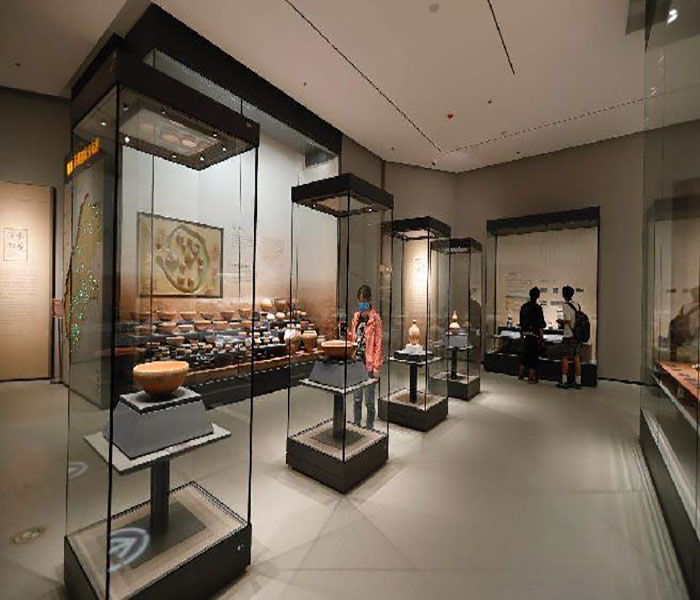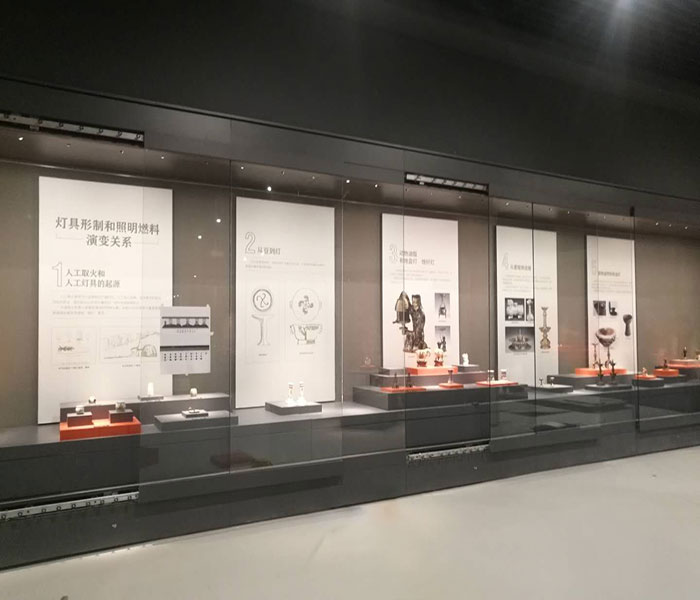Low-reflective laminated glass manufacturers [reveal] Zhejiang museum display case glass preparation method and application status quo! Zhejiang Museum display case glass is also known as low-reflection glass or anti-glare glass. The preparation method of the present invention is to apply a special surface treatment process to one or both sides of a high-quality original glass sheet with low reflectivity (4%-8%-1%-2% of the original ordinary glass) without affecting the transmittance. Even under strong light, the glass can produce diffuse reflection, which further reduces the reflection of the screen, improves the visibility and brightness of the display, makes the image clearer and the colors more saturated, thus producing a good visual effect, creating a clear and transparent visual space, and allowing the viewer to experience a better visual enjoyment.

I. Zhejiang museum display case glass application situation.
In recent years, the Zhejiang Museum display case glass enterprise development economy has been rapid, application service scope has also more and more extensive. Based on our human survival and continuity, energy market demand has become the main research to carry out the development of the theme. However, due to the limited level of human cultural cognitive learning ability, and energy resources utilization technology management there is a great impact on different degrees of waste, resulting in the structure of China's energy supply continuing to appear tense. Zhejiang Museum display case glass with anti-glare characteristics and high transmittance advantages, and solar collectors, solar cells supporting the use of solar energy can not only improve the absorption rate of solar energy, a more effective way to solve the traditional solar energy device of the reflected light pollution. Solar energy conversion and utilization devices have now entered thousands of households, realizing the integration of building and solar energy utilization.
Especially in traffic command and remote areas and other special occasions, Zhejiang Museum display case glass also has an irreplaceable role. With the advancement of urbanization, glass curtain wall as decoration are increasingly used in high-rise buildings constructed around the world, and the resulting light pollution is also becoming more and more serious. On the one hand, light pollution is a traffic accident **, in the hot sun, traffic signals and vehicles will pass through the road next to or at traffic junctions of high-rise buildings glass curtain walls produce reflected light. Reflected light can cause sudden temporary blindness and visual illusions to drivers, seriously endangering pedestrian and driving safety. On the other hand, glass curtain walls near residential areas will reflect light onto surrounding buildings, which will inevitably cause certain problems for nearby residents.
Since light pollution caused by reflected light is difficult to eliminate or reduce by decomposition, transformation, or dilution, Zhejiang Museum display case glass has become an ideal material for high-grade architectural glass. In our daily lives, we all have the experience of being attacked by glare, partly from the source of glare and partly from the reflection of glare. For example, when operating a computer, the presence of glass windows makes LCD monitors and LCD touchscreens reflect light so that people cannot see what is being displayed. The use of Zhejiang Museum display case glass glass windows can effectively solve the problem of glare pollution.
Two.’ Preparation method of ‘Zhejiang museum display case glass’. Zhejiang Museum display case glass can be applied to solar collectors, advanced photo frames, liquid crystal displays, industrial instruments, touch screens, and so on. By using spraying, sol-gel impregnation, magnetron sputtering, vacuum evaporation, or acid etching to reduce its surface light reflectivity and enhance its ** performance.
1, spraying method, the first need to clean automotive glass, to be dry after the study of spraying; configure a good lithium silicate solution, and then clean and process glass panels as heated to 50 ~ 60 ° C, the use of pressurized low-flow rate as well as a jet control system to the heated glass panels between the surface through the spraying of lithium silicate aqueous solution; and finally, will be coated with good glass panels are heated to about 200 ° C themselves and then according to the cooling, the And then use 50 ~ 60 ℃ of water to the glass material surface data to clean a clean, dry can be.
2, this invention sol-gel dip plating method is in the ordinary flat glass front and back to form an anti-reflection film layer, which not only greatly reduces the reflectivity of the ordinary glass surface but also can improve the visual clarity of the glass.
3, the present invention by continuous plating of multiple dielectric films (TiO2 and SiO2) on the surface of the glass, so that the glass has a low reflectivity, light transmittance increased to more than 98%. The method is a complex process, has high environmental and equipment requirements, high cost, suitable for manufacturing high-end technology products.
4, a vacuum evaporation method, in the glass surface plating a layer of magnesium fluoride and another reflective film. This method is mainly applicable to camera lenses, filters, and other small precision optical components. The method of preparation of the ‘Zhejiang Museum showcase glass’ anti-glare effect is good, is the preparation of ‘Zhejiang museum showcase glass’ is an important way. However, the process is complex, high cost, in strong light or outdoor wind and rain and other harsh conditions are not corrosion-resistant, poor scratch resistance. After some time, it is easy to wear and shine, and the coating is easy to fall off or discoloration, thus losing the anti-glare effect.

5, acid etching method, as a study of low investment, low energy consumption of glass surface treatment method, acid etching processed glass development with abrasion resistance, long shelf life, etc., suitable for large-area glass etching as well as large-scale enterprise Zhejiang museum display case glass production. However, the etching solution used is mainly composed of acidic fluoride, even if we can effectively overcome the coating method it easily falls off, and the surface is easy to scratches the defects, due to the fluoride volatile, the working and living environment is susceptible to serious pollution, there is a need for a certain degree of safety risk hidden danger. Another important aspect, the waste etching solution can only be discharged after such treatment to meet the standards, processing management is very difficult, but also easy to causes pollution of the social environmental governance, while the information processing financial costs are high, a substantial increase in the cost of production and operation, affecting the effectiveness of China's economic construction.






